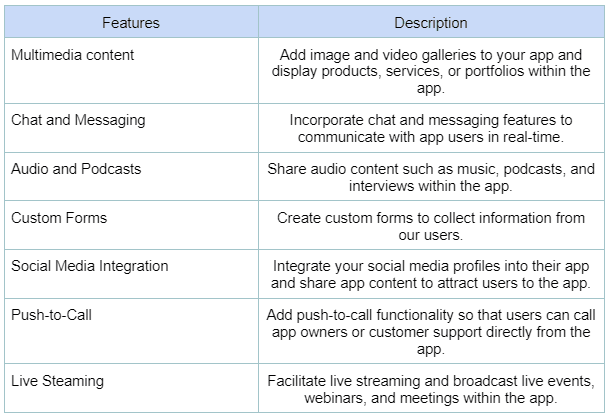The ever-evolving tech world is pushing its boundaries and removing the dependency on involving third-party experts in building a mobile application.
Modern technology has ideally proven that there’s nothing humans can’t do alone and building an app yourself is the best example trending on the Internet today.
With the right amount of development skills, a thorough understanding of technology infusion, and a practitioner of codes, you can do what an expert mobile app developer does after years of hard work.
How to get started with app development? Well, we’ll guide you through whatever is needed to become a pro in creating your very own app for free.
Before we proceed further, if your app development is only specific to Android then we have a thorough written guide for you, click here to continue reading!
How to get started with app development?
- Plan out what you want to develop
- Start with the research part
- Pick out your app name
- Create a logo and color theme
- Install all the necessary plugins and APIs
- Choose an app development framework like Xamarin, Flutter, or React Native app development services.
- Choose the testing device
- Create a basic code structure
- Run the built app on the device
- See the results by sharing the app with the developer’s community.
Types of App Development Approach
It’s crucial to understand the various procedures before starting your adventure. You must be aware of these techniques and their benefits and drawbacks in order to ensure that you receive the greatest outcomes and build an app that precisely accomplishes your goal.
The procedure comprises using technology to develop software programs that may be used with portable electronics like smartphones or tablets.
-
Code your app yourself
This choice strikes me as being the most daunting. Learning to code before completely coding the mobile app yourself might be more of a nightmare than a dream for a layman developing an app by himself for the first time.
But if you know how to code, this is a fantastic method to make a mobile app for nothing. In addition to having highly developed talents, getting the app up and running takes a significant amount of time.
This approach is preferred by programmers because it allows them to produce native mobile app development that takes advantage of the device’s native features and offers a more advanced app experience.
However, developing a native app necessitates producing unique mobile apps for every OS. As a result, you will need to master different programming languages, such as Java or Kotlin for Android apps and Objective-C or Swift for iOS apps.
This approach is ideal for developing an app all by yourself that meets your precise requirements if you have the necessary skill set.
Benefits:
- Native device capabilities
- Offline potential
- Maintain aspect ratios and resolution
- Recognizable appearance and feel
- Swift and receptive
- Outstanding user experience
Drawbacks:
- Little flexibility
- Requires significant time and money investment;
- More upkeep and care
- The app must be downloaded by users on their devices.
- Require regular updates
2. Hire an App Development Company or a Processional
Not everyone possesses the necessary knowledge to build an app from the ground up for both Google Play and the Apple App Store. But it doesn’t mean you have to abandon your plans to build an app from scratch.
Multiple professionals are available for projects or long-term employment. Depending on your needs, you might seek employees who have experience creating apps for either iOS or Android. However, if you want to make apps for every operating system, it might get pricey.
You may either seek a mobile app development company in Australia like DianApps that has numerous professionals to handle apps for all operating systems, or you can engage specialized experts individually for each of the apps.
Pros
- Large teams at agencies
- The organizations are knowledgeable.
- Gives you time to concentrate on other things
- Continuous accessibility
Cons
- Gaps in communication
- Worries about data privacy
- Limited ability to influence the process
- Expensive to make even small adjustments
3. Go For an App Builder
Deep understanding and proficiency in a range of programming languages are required to build your own software from the ground up. Although it could save you some time, hiring a company or expert to design your mobile apps can be pretty pricey. App builders, on the other hand, are a terrific alternative for startups, company owners, and small enterprises with limited resources and time.
Anyone may quickly construct an app using a no-code platform known as an app builder. You can create applications quickly, and you can publish them on popular app stores so that consumers can search, download, and use them right away.
Most app builders include a drag-and-drop interface that enables platform users to add feature blocks to their apps without having to learn how to code. Using Appy Pie’s app builder to create an app will save you time and money. Without knowing how to code, anybody with a smartphone connected to the internet may quickly and easily hire app development services from DianApps for more effective app builder expert advice.
Pros
- A quick time to market
- The cost of app development is lowered
- Scalable, flexible, and extendable
- 24-hour assistance
- Simple updates
- No coding is required
- Bricks that resemble Legos
- Integrated third-parties
- Enhanced agility
- Low GTM period
- A cross-platform capability
Cons
- No source code belongs to you.
- Lack of control might result in security problems
- Customization may be limited by rigid templates.

Steps to Build Your App Yourself
Step 1: Choose your app name
How your app users view you and your company depends on the name of the app. It is advised to stick with the same or a similar name if your business is currently successful so that your current clients can locate you easily and have confidence in your app. You are allowed to select any name you like if you are just starting off, though. You might consider the following factors to help you choose the ideal name for your app:
- The name ought to correspond to the brand you have in mind.
- The app’s name should be distinctive while also being simple to say and remember.
- Your app’s name should be chosen with your users’ characteristics in mind.
- Avoid using jargon and explain the app’s benefits directly.
- Even if you are just (yet) serving a small market, the app name should have a broad appeal.
Step 2: Choose a color scheme
You are one step closer to finding the answer to how to construct an app once you have picked the name of your app and the proper business category it should go under. It’s time to choose the color scheme that will work best for your mobile app development now.
We consume with our eyes first, thus the color scheme you decide on for your mobile app is quite important.
Your choice of color scheme is influenced by a number of factors. The brand image you wish to develop comes first. Let’s go through every consideration you need to make when selecting the ideal color palette for your app.
- Brand identity, brand colors (if applicable),
- Target market and your customer persona
- Product line or any USPs
Step 3: Personalize your app design
Your app’s visual appeal is crucial, therefore you need to consider more than simply the color palette while designing it. How to create a beautiful app is now the question!
Customizing your app’s appearance and feel will help it stand out from the competition when you create it using our best-in-class UI/UX design services. You can experiment with various visual elements that give your app its unique look in the design customization area.
Have a look at our blog which defines intuitive UI/UX design tools for contemporary designers.
Customization options:
- App icon, background, and splash screen
- App layout
- Fonts and colors
Step 4: Choose the right test device
It is quite normal to ponder how to create an app that looks excellent on the device of your choice and how consumers would perceive it.
One of the most thrilling aspects of the process is when you finally get to see the fruits of your labor. You may download the app on the device of your choosing by using the link or the QR Code. You will be able to preview how your app will seem to app users once it is ready and installed on your phone.
Step 5: Install the app on your device
It makes sense that you would want to see how your app appears on a real device while you learn how to design an app. One of the most thrilling aspects of the process is when you finally get to see the fruits of your labor.
Step 6: Add the features you want (Key Section)
Now that you are familiar with the fundamental steps involved in creating an app, let’s explore the most important and well-liked aspects of the platform.
How to make an app that your clients would like to use is the appropriate question to ask at this moment. It’s crucial to include the appropriate features in your own built app, characteristics that not only complement it but are also necessary for you to provide the greatest possible client service. Of course, that depends on the purpose of the app you’re developing.

Step 7: Test Before You Launch
You’re not necessarily ready to launch your app just because you know how to create one!
It is normal to believe that your product is the finest and most perfect product ever. For any new product, it is quite uncommon for this to be the case. It’s crucial to devote some time to thoroughly testing your app when you create it yourself.
Programmers that cut corners on this phase frequently pay a high price for it. The problem emerges when an untested program goes live and is infected with bugs and has multiple crashes that may have been completely prevented. It may appear like you are saving time by bypassing this stage.
Potential app users or independent testers perform alpha testing, which is primarily a simulated or occasionally genuine operational testing, at the programmers’ location.
The release of the beta versions of the software to a select group of users (who are not members of the programming team) is known as beta testing. If you want your app to work properly, beta testing is essential, and we have a straightforward 10-step approach to get you through it.
Once you have made any necessary changes to the app in light of the testing process findings, you are prepared to go on to the next phase, going live!
Step 8: Make your app public
Any app developer’s most eagerly anticipated moment is when their app will launch on app marketplaces! How to publish my app has replaced the earlier query of how to create an app. The excitement takes place here! distinct app stores have distinct procedures for publishing apps, thus we have produced specialized instructions to assist you with both.
Your app customers may easily go there and download your app from there once you have released your Android app on the Google Play Store and your iOS app on the Apple App Store.
If in case, you are willing to know how the marketplace works and how can you create a marketplace app yourself, here’s the perfect guide you need!
Step 9: Market your app.
In the realm of marketing, just because you created a fantastic app and put it up on the app store doesn’t guarantee that users will flock to download it. This implies that even if you know the solution to the issue of how to create an app, you still need to consider how to market it.
You must be ready for the possibility that people may already be using a certain solution while developing an app with the intention of providing a remedy to any current problem. You would need to consider your strategy for persuading them to change.
Marketing can help here, of course!
The app stores have millions of apps, therefore you need to stand out, and marketing is the method to do it!
Step 10: Request opinions from your users.
In the realm of marketing, just because you created a fantastic app and put it up on the app store doesn’t guarantee that users will flock to download it.
- App analytics for quantitative data collection
- Gathering qualitative data via questionnaires and interviews
- Building a relationship with the app users by regularly communicating with them is one way to create your own app.
Sending your app users an email and politely requesting their feedback on how they are using your app is one of the simplest methods to do this. Ask them how they are using the software rather than if they enjoy it.
Conclusion
That’s it! Now you know the tips and tricks to start building your own personalized app all by yourself. So, if someone asks you can you build an application alone? You know what you have to do to get hired and become a professional.
Hire DianApps’ mobile app development services for a better, synchronized, and first-hand app development approach.










Leave a Comment
Your email address will not be published. Required fields are marked *